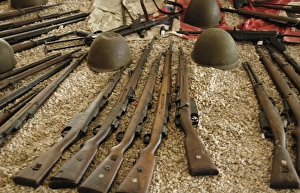"Unleashing the Power: Submachine Guns in Warfare" From the air-raid defense maneuvers in Rome during World War II to French dragoons with machine guns during the First World War, submachine guns have played a crucial role in shaping history. These powerful weapons, showcased at the Military Museum of the Cit and captured through black and white photographs, tell tales of bravery and strategic warfare. In an album capturing moments from the First World War in Friuli-Venezia Giulia, we see group portraits of gunners soldiers armed with rifles and submachine guns. The intensity on their faces reflects their determination to protect their comrades and secure victory amidst chaos. One notable figure who utilized submachine guns was F. A. Mitchell-Hedges, a British adventurer known for his daring exploits. His target practice using these innovative firearms in 1920 exemplifies how technology progressed rapidly after conflicts like WWI. The significance guns extends beyond Europe's battlefields. In Okinawa during 1945, a U. S. Marine takes aim at a Japanese sniper near Shuri town – showcasing how these weapons were instrumental even in Pacific theater combat. Meanwhile, American cinema depicted the last gangster film era where political leaders like U. S President Franklin Roosevelt and British Prime Minister Winston Churchill were satirically portrayed by Ralph Soupault for Le Petit Parisien newspaper. This artistic representation highlights how influential figures recognized both the power and impact of such weaponry during wartime struggles. As Soviet Russian soldiers triumphantly enter Berlin's Frankfurter Allee railway station in 1945, it is evident that submachine guns played a pivotal role not only on European soil but also across continents as they helped shape post-war boundaries. Even today, conflicts continue to arise worldwide; one example being North Kivu in Congo's Democratic Republic where armed forces rely on modernized versions of these historic firearms to maintain peace amid turmoil.









